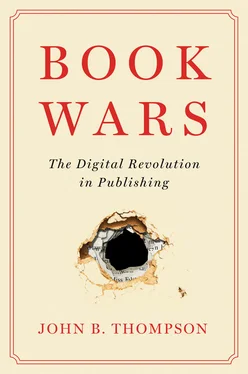The third key development that shaped the field of Anglo-American trade publishing was the growth of the publishing corporations. From the early 1960s on, several waves of mergers and acquisitions swept through the world of Anglo-American trade publishing, and many formerly independent publishing houses – Simon & Schuster, Scribner, Harper, Random House, Alfred Knopf, Farrar, Straus & Giroux, Jonathan Cape, William Heinemann, Secker & Warburg, Weidenfeld & Nicolson, to name just a few – were transformed into imprints within large corporations. The reasons for these mergers and acquisitions were complex and they varied from case to case, depending on the circumstances of the houses that were being acquired and the strategies of the acquiring firms; but the overall result was that, by the late 1990s, the landscape of Anglo-American trade publishing had been dramatically reconfigured. In a field where there had once been dozens of independent publishing houses, each reflecting the idiosyncratic tastes and styles of their owners and editors, there were now just five or six large publishing corporations, each acting as an umbrella organization for numerous imprints and each owned, in turn, by a much larger multimedia conglomerate that stood behind it and to which the publishing corporation reported. Most of these conglomerates were large, diversified, transnational businesses with interests in many different industries and countries. Some, such as the German groups Bertelsmann and Holtzbrink, remained private and family-owned, while others, like Pearson, NewsCorp, Viacom and Lagardère, were publicly traded companies. In most cases, these conglomerates acquired trade publishing assets both in the US and in the UK, assembling them under a corporate umbrella that carried the same name – Penguin, Random House (now Penguin Random House following their merger in 2013), Simon & Schuster, HarperCollins, Hachette or Macmillan – even if in practice the operations in the US and in the UK operated largely independently of one another and reported directly to the parent company.
The large publishing corporations became major players in the field of Anglo-American trade publishing, together accounting for around half of total retail sales in the US and the UK by the early 2000s. In a field characterized by large retail chains and powerful agents who controlled access to customers and content respectively, there were clear advantages to being big. Scale gave them leverage in their negotiations with the large retail chains, where terms of trade could make a real difference to the profitability of the publisher. It also gave them access to the deep pockets of the large conglomerates, which greatly strengthened their hand when it came to competing for the most sought-after content, where, thanks in part to the growing power of agents, the size of the advance was often the decisive consideration. Smaller and medium-sized publishers simply couldn’t compete with the financial clout wielded by the new publishing corporations, and many eventually hauled up the white flag and joined one of the groups.
In broad terms, these were the three developments that shaped the field of Anglo-American trade publishing during the last four decades of the twentieth century, from roughly 1960 to the early 2000s. Of course, there were many other factors that were important in shaping this field, and many other organizations that were active and significant players in the world of trade publishing during this time: this is a world of bewildering complexity, full of arcane practices, highly ramified supply chains and countless organizations doing a myriad of different things. But if we wanted to understand why the world of Anglo-American trade publishing in the 1980s, 1990s and early 2000s was so different from the world of trade publishing that existed in the 1950s and before, and if we wanted to understand the most significant practices that had become prevalent and taken-for-granted in the industry by the early 2000s – including auctions for new books, mouth-wateringly high advances, stack-’em-high book displays in the major retail outlets, bestsellers on a scale and with a frequency that was unprecedented, high discounts and high returns – then the three developments outlined above would give us the keys.
It was in the context of an industry structured in this way that, from the early 1980s on, the digital revolution began to make its presence felt. Initially, this was a low-key affair, invisible to the outsider. Like so many other sectors of industry, the early impact of the digital revolution was in the area of logistics, supply-chain management and the gradual transformation of back-office systems. For an industry like book publishing, where thousands of new products – that is, books – are published every week, each bearing a unique numerical identifier or ISBN, the potential for achieving greater efficiencies in supply-chain management through the use of IT was enormous. Huge investments were made throughout the 1980s and 1990s to create more efficient systems for managing all aspects of the publishing supply chain, from production, rights and royalties to ordering, warehouse management, sales and fulfilment. Improved IT systems enabled publishers to manage the publishing process more efficiently, enabled wholesalers to offer much better services to retailers, and enabled retailers to monitor their stock levels and re-order on a daily basis in the light of computerized point-of-sale data. Behind the scenes, the entire book supply chain was being quietly but radically transformed. These were not the kinds of developments that would get blood racing through the veins, but it would be hard to overstate their significance for the day-to-day operations of the publishing industry.
Yet the digital revolution in publishing was never going to be only about the logistics of supply-chain management and the improvement of back-office systems, however important these things are in the day-to-day running of businesses. For the digital revolution had the potential to be far more disruptive than this. Why? What was it about the digital revolution that made it so much more disruptive, indeed threatening, than the many other technological innovations that had impinged on the publishing industry often enough in the course of its 500-year history?
What made the digital revolution unique is that it offered the possibility of a completely different way of handling the content that was at the heart of the publishing business. For, at the end of the day, publishing, like other sectors of the media and creative industries, is about symbolic content – that is, about a particular kind of information that takes the form of stories or other kinds of extended text. What the digital revolution made possible was the transformation of this information or symbolic content – indeed, any information or symbolic content – into sequences of digits (or streams of bits) that can be processed, stored and transmitted as data. Once information takes the form of digitized data, it can be easily manipulated, stored, combined with other data and transmitted using networks of various kinds. Now we’re in a new world, very different from the world of physical objects like cars, refrigerators and print-on-paper books. It is a world of weightless data that can be subjected to a whole new set of processes and transmitted via networks that have their own distinctive properties. And the more that publishing is drawn into this new world, the further it moves away from the old world of physical objects which had been its home since the time of Gutenberg. In short, the symbolic content of the book is no longer tied to the physical print-on-paper object in which it was traditionally embedded.
This, in essence, is why the digital revolution has such far-reaching consequences for the publishing industry and for other sectors of the media and creative industries: digitization enables symbolic content to be transformed into data and separated from the material medium or substratum in which it has been embedded hitherto. In this respect, publishing is very different from, say, the car industry: while the car industry can be (and has been) transformed in many ways by the application of digital technologies, the car itself will always be a physical object with an engine, wheels, doors, windows, etc., even if it no longer has a driver. Not so the book. The fact that, for more than 500 years, we have come to associate the book with a physical object made with ink, paper and glue is, in itself, a historical contingency, not a necessary feature of the book as such. The print-on-paper book is a material medium in which a specific kind of symbolic content – a story, for example – can be realized or embedded. But there were other media in the past (such as clay tablets and papyrus) and there could be other media in the future. And if the content can be codified digitally, then the need to embed that content in a particular material substratum like print-on-paper, in order to record, manipulate and transmit it, disappears. The content exists virtually as a code, a particular sequence of 0s and 1s.
Читать дальше












